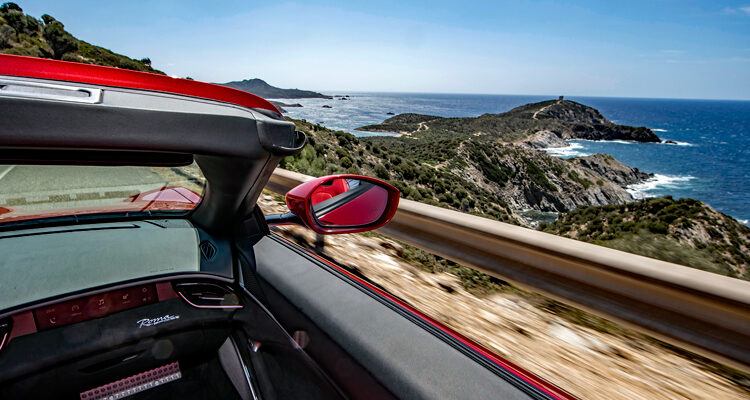This review was first published in the Fall 2023 issue of Vicarious magazine. Subscribe here and never miss an issue!!
If you ever have the chance to drive a Ferrari in any part of Italy, it is so choice. Eight years ago, this humble servant piloted a Ferrari 488 Spider through and around the coastal town of Ravenna on a bright autumn day. Despite the chill, the occasion called for the top to be down (naturally), while the heater was set to 24 degrees C to balance out the conditions.
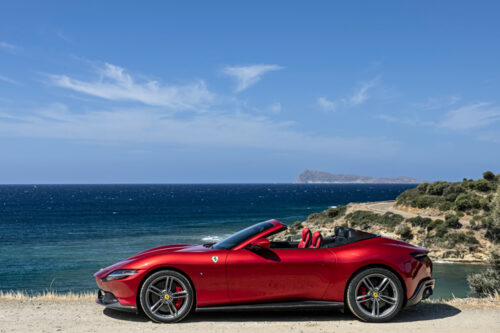
Rumbling through the town at slow speed produced a similar reaction, one might imagine, to the pontiff being paraded around in the popemobile. The people stopped, stared and whistled, enrapt by the car itself, then amused at the sight of the driver shivering behind the wheel.
This time around, the occasion was the island of Sardinia and the car was the 2024 Ferrari Roma Spider. Now, the island is a more sparsely populated part of Italy and the drive route didn’t see us spend much time in urban areas. But there was nevertheless a real sense of drama as we took to a mountainous road overlooking the southern coast, a route favoured by tourists and locals alike.
Around every bend, there were people surprised at the sight of this glorious, sinewy roadster. It’s no wonder Ferrari use the phrase “the new dolce vita” to label the driving experience—this car is all about recalling a more romantic era. It follows, then, that the most crucial aspect of the Roma Spider is not its outright performance.
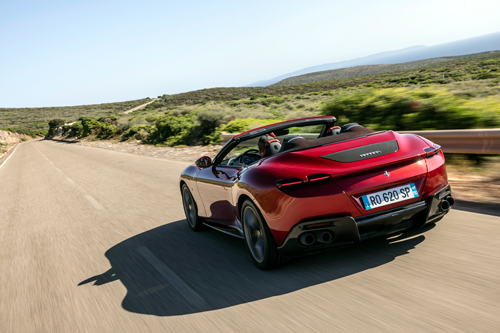
First of all, this Ferrari is drop-dead gorgeous. But that’s not all. It’s a real looker with the top up or down, a remarkable feat of design. Most convertibles seem like afterthoughts compared to the Ferrari, their proportions only look correct either open or closed.
The five-layer soft-top roof itself is also available in any number of bespoke hues. A few of the test cars featured the Rosso Portofino paint scheme along with a two-tone red-and-black woven roof—simply stunning. The power roof also features a Z-shaped movement, an elegant design that sandwiches the mechanism into a small compartment above the trunk.
The roof can be lowered at speeds of up to 60 km/h—perfect for when the weather makes a quick shift—with the process taking 13.5 seconds. A patented wind deflector pops out from behind the front seats to help slash buffeting during those high-speed runs.
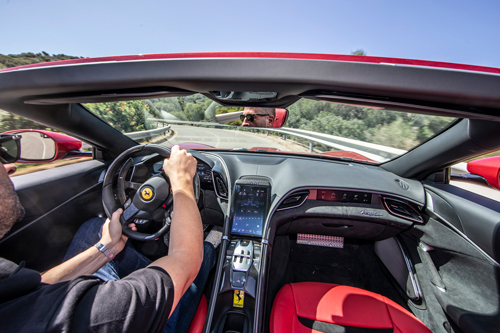
The passenger cabin adopts the classic twin-cockpit design for the driver and co-driver, each cocooned within her or his own space. The two areas are somewhat symmetrical in design, particularly when the Roma Spider is equipped with an optional screen in front of the passenger, which displays driving information. The controls for the 8-speed dual-clutch automatic gearbox are set within a gated shifter design, which mimics the look of older Ferrari models that had manual transmissions. The steering wheel features the legendary manettino, which is used to select drive modes and adjust the suspension system.
It’s all very F1-inspired, as all current-generation Ferrari models are, and it gives this convertible GT a leg up over anything else in the competitive set. Also, as with many current-generation Ferrari models, the only significant criticism is the less – than — intuitive nature of some of the controls. This approach to ergonomics clearly takes some time to learn, a task that I would happily take on at any time, anywhere in the world, should the need arise.
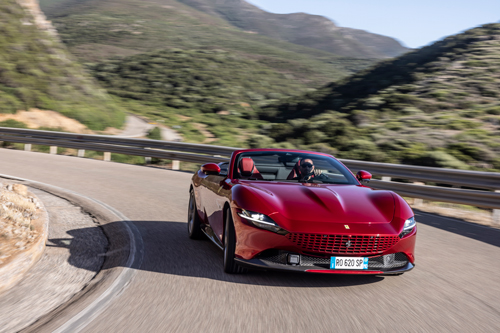
Although perhaps not headline-worthy material, we can’t leave the Ferrari Roma Spider behind without some mention of its performance and what it feels like to drive at speed.
As with the Roma coupe, the Spider is powered by a twin-turbocharged 3.9-litre V-8 engine, which churns out 612 horsepower at 7,500 rpm and 561 pound-feet of torque at 3,000 rpm. Although the convertible gives away some 80 kg compared to the coupe, tipping the scales at 1,556 kg, it’s still fast—very fast. The thing launches to 100 km/h in just 3.4 seconds and motors on to a top speed in excess of 320 km/h.
The upshot: You can cruise around in the Roma Spider as slow as possible and still turn heads like a Rubik’s cube. But you can also pin it and leave all onlookers behind in a cloud of dust and balled-up bits of rubber.
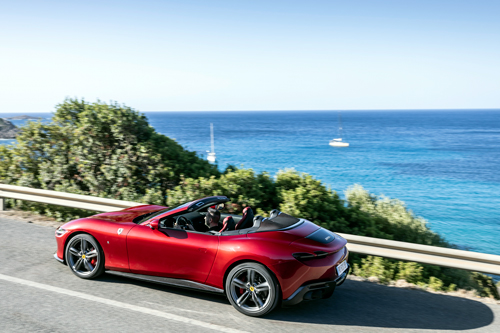
On that same coastal road in southern Sardinia, when the traffic allowed, the Ferrari proved capable of devouring huge swaths of tarmac with lightning speed. The transmission is, of course, a willing accomplice to the twin-turbo engine, capable of rapid-fire shifts up or down whenever the mood struck. (It struck plenty).
Then, with the car carrying serious speed into the tight and blind turns, the carbon-ceramic brakes, once accustomed to the task at hand, threw out the proverbial anchor with alarming ease. The brake pedal was on the soft side to begin with, the result of an earlier drive group getting their turn behind the wheel, but it just became better and better as the drive went on.
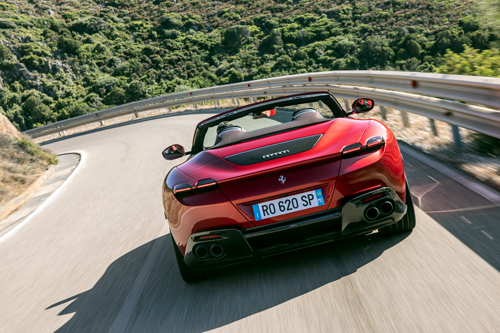
In terms of handling, when pushed closer to its natural limits, the Ferrari’s slightly rear-biased weight distribution seemed to come into play. The feel at corner entry was fantastic, but once the brakes were released, the nose had the tendency to lift and understeer mildly off-line.
It doesn’t seem like the Roma Spider would be a car that favoured more trail braking, but that may well be the case. Only time will tell if Ferrari decides to take the car to a track to let people really cut loose. Without a doubt, this machine is perfectly suited to the closest winding road. It’s effortlessly fun within a certain operating window—and that window is not far off being wide open.



